This soba noodle tutorial came out of a complete fail of a meal I made once when my mom was in town. She wanted me to make a noodle bowl. I can usually rock these. Some sort of grilled meat with loads of veggies and a simple sauce with a noodle base. Easy enough right?!
Unless you screw up the noodles. I overcooked the noodles by about 30 seconds (because beer) and they turned into a gummy mess of a thing. Not exactly what I had in mind.
If I can screw it up, I figured I’m not the only one. So, I figured I would post the correct way to cook perfect soba noodles every single time. Step one is to ditch the instructions on the box that the soba came in. They are almost certainly wrong!
What are Soba Noodles?
Soba noodles are a big deal in Japan and are becoming more popular in the United States as people slowly realize how amazing they are. They are made with buckwheat flour most of the time, although there are some alternatives.
Soba noodles tend to be more delicate than other noodles (except maybe glass noodles). If you overcook them, they become a weird, gummy mess and aren’t exactly fun to eat.
But, they are also a wonderful noodle to master. They have a naturally nutty flavor and my favorite aspect of soba is that they are almost better cold than hot (in my opinion). Cold soba noodles, especially in the dead of summer, can be a refreshing meal.
Many times, cold soba noodles are served with a chilled dipping sauce (like this version from Serious Eats) and can be served with all manner of veggies and spicy or savory toppings.
Are soba noodles gluten free?
The short answer is… it depends. In generaly, it’s true that soba noodles are gluten-free if they are made from 100% buckwheat flour. Buckwheat flour doesn’t contain gluten so you should be fine.
That said, it’s not 100% across the board true. For starters, there is a variety of soba noodle called Nagano Soba that contains wheat flour along with buckwheat flour. Also though, it can be the case that soba noodles are manufactured on the same line as wheat flour noodles.
If gluten-free is a concern, I would always double-check the label and maybe even test the noodles with a gluten sensor even though in theory buckwheat noodles should be gluten free.
Tips for Perfect Soba Noodles
Soba noodles are buckwheat noodles and they are much more fragile than, say, spaghetti. They cook faster and are much more delicate. While Italian pasta can stand a bit of overcooking, most soba noodles will turn into a complete mess if you overcook them.
So that’s our main rule here: Don’t overcook them!
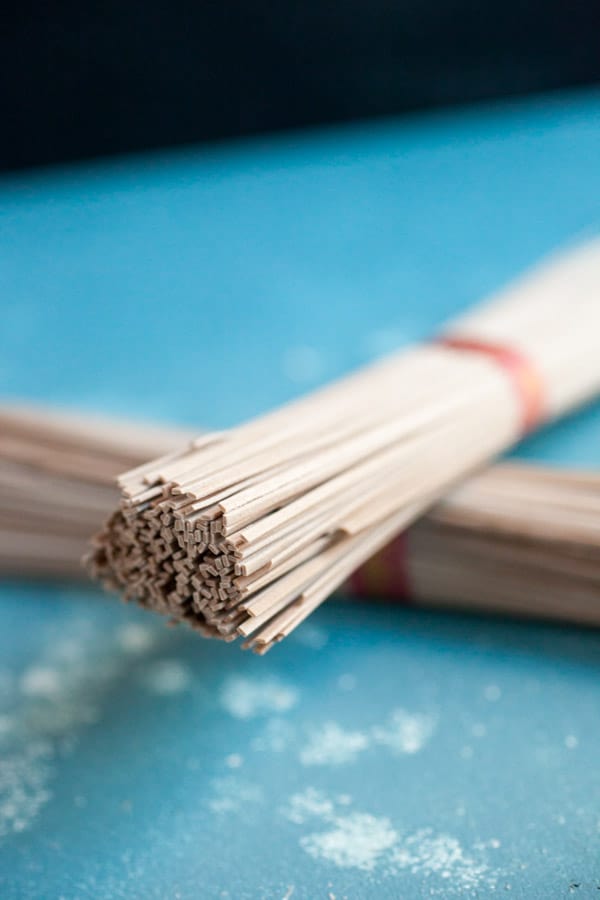
The other big problem that can happen with soba noodles is clumping. You need to give them a lot of room to cook. I bring a big pot of water to boil for even 6-8 ounces of soba noodles. Give them lots of room to wiggle around as they boil.
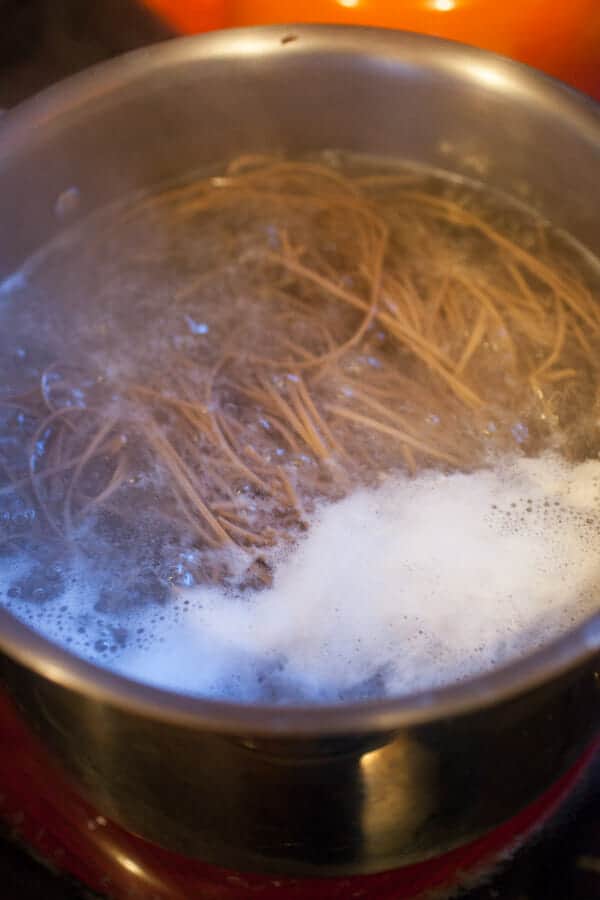
SET A TIMER. Seriously. I’ll eyeball spaghetti, but not soba. 150 seconds. Most boxes will say three minutes, but I think that’s a bit long after a few tests. I like to err on the side of al dente.
Two and a half minutes and then they are out of the hot water and into cold water. This is the second most important step besides the timer. You have to cool these down as soon as possible. I prefer putting them in a bowl of cold water over rinsing them with cold water because rinsing them compacts the noodles down while the bowl of cool water gives them room to stay separate.
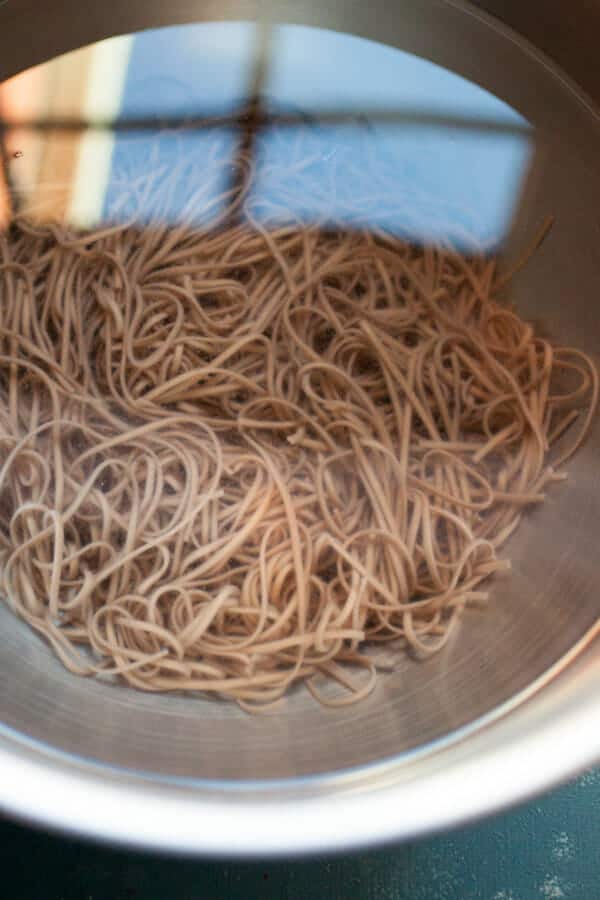
Once the soba noodles are cooled down you can keep them like that for a bit or drain them and dry them out on a few paper towels.
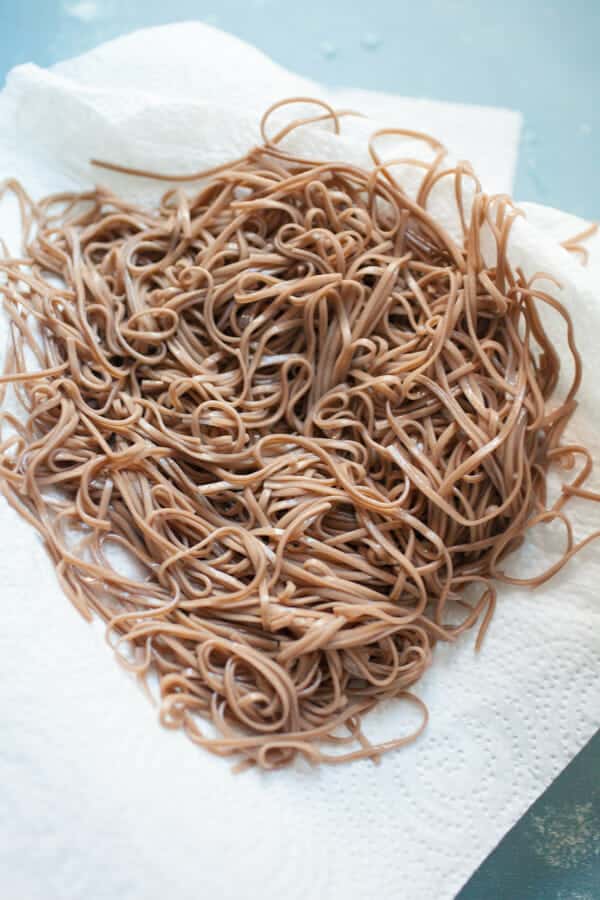
My preference is to drain them and then toss them with a small dash of sesame oil and soy sauce which will keep them from sticking and season the noodles nicely.
- Want an easy vegetarian Asian dish? Try these Crispy Tofu Wraps!
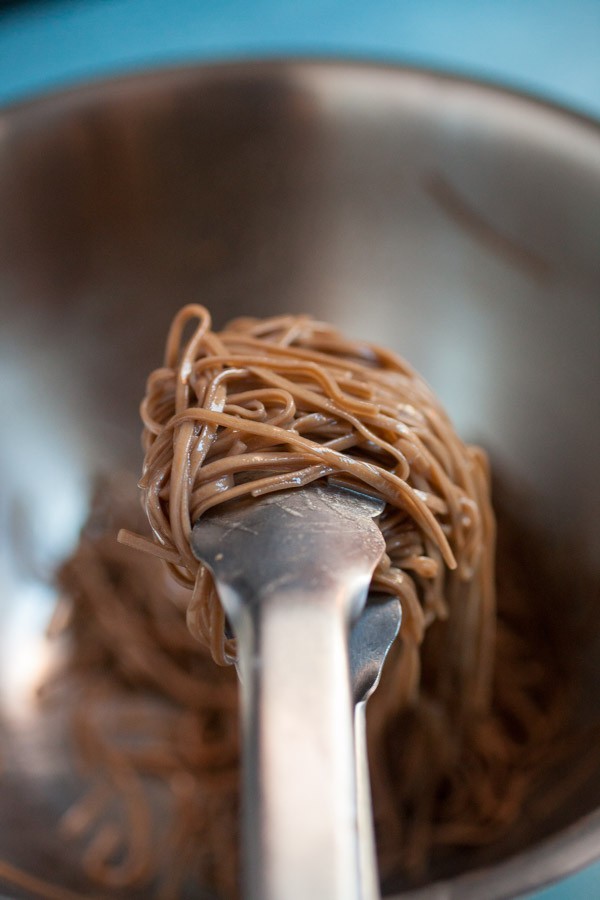
The soba noodles are cold at this point and I actually prefer cold soba noodles, but if you want them hot, just dunk them in a pot of hot stock or water right before serving them.
What to serve with soba noodles?
Soba can be a very simple dish. For the most basic version, garnish with chives and sesame seeds and you’re in business.
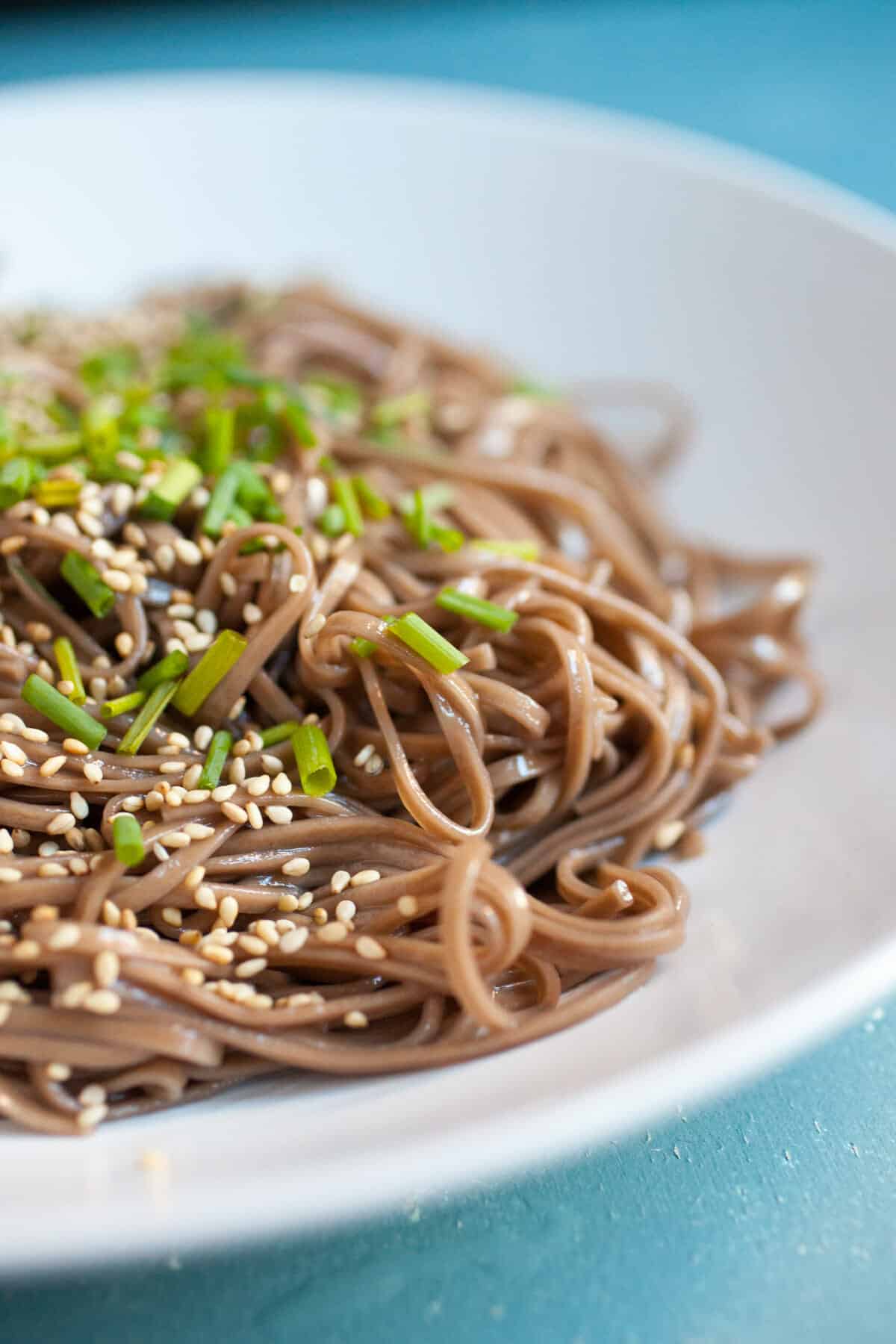
Here are a few other ideas for your soba noodles though:
- Make a cold soba picnic salad with sesame oil, edamame, sesame seeds, seared tofu, and chili flakes.
- Use them in a stir-fry topped with grilled protein and crunchy veggies.
- Add them to a warm soup (think soba chicken noodle soup)
- Add them to kid’s lunchboxes. They are amazing at room temperature or slightly chilled.
Raise your hand if you’ve ever screwed up soba noodles and never want to do it again! ✋✋✋✋
How to Cook Perfect Soba Noodles
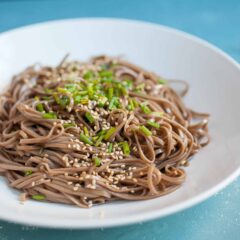
Ingredients
- 3 oz. dried soba noodles
- Sesame oil
- Soy sauce
- Sesame seeds
- Scallions
Instructions
- Bring a large pot of water to a rapid boil. Add soba and use tongs to spread out. Cook for 150 seconds (2 1/2 minutes).
- Immediately drain soba and transfer to a bowl with cold water to stop the cooking.
- Once soba is cooled, drain and transfer to a few paper towels to dry.
- Toss cooled soba with a small drizzle of sesame oil and soy sauce. Maybe 1 teaspoon of both.
- Eat immediately with sesame seeds and/or scallions.
- You can also reheat the soba by quickly dipping it in hot water or stock.

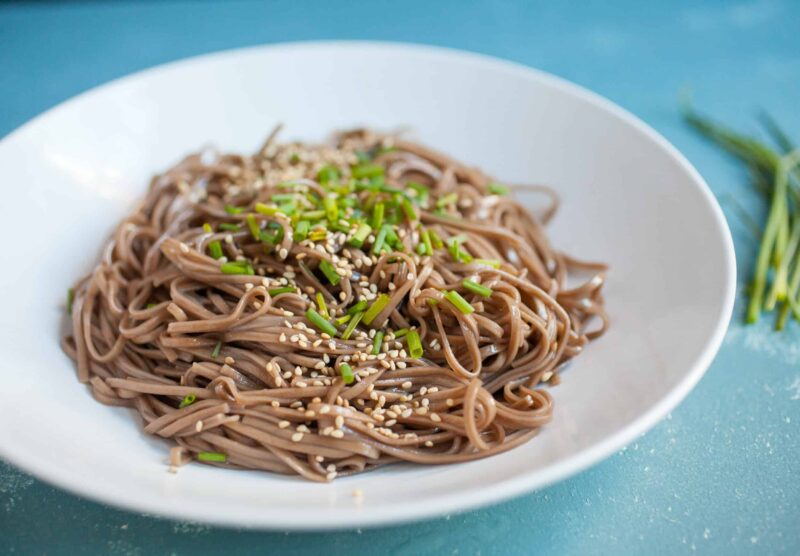
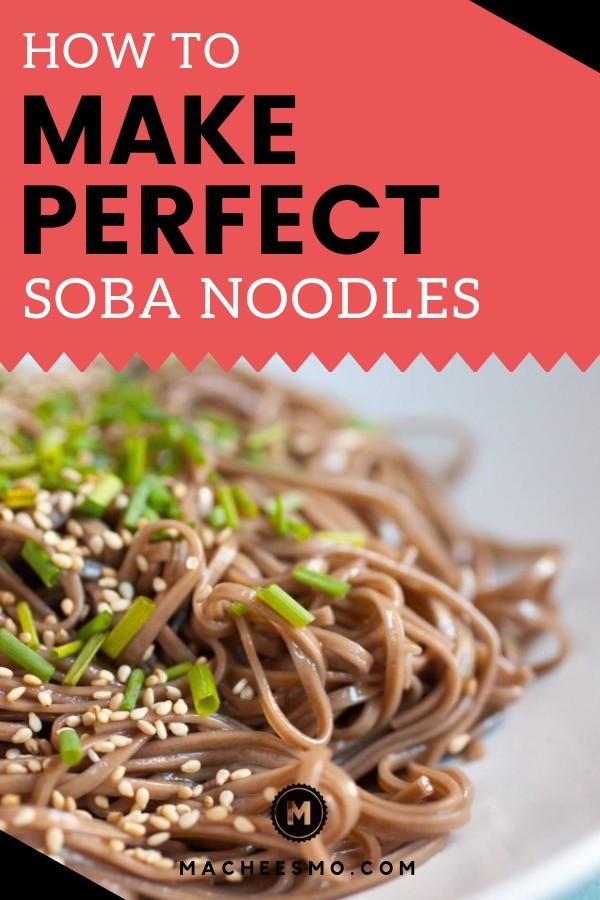
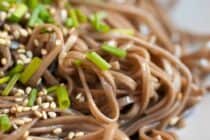
Velva
You are absolutely right! Noodles or other grains can go from perfect to gooey in just a matter of seconds. Thanks for sharing!
Velva
Rosalind
Agree totally soba noodles are touchy. I’ve cooked them a few times and you have to be spot on to get them just right. They are delicious especially with a few herbs and spices. Yum! :)
Constance
I’m not generally a huge fan of soba because it tends to be grainy and mushy but this looks so good I’ll definitely give them another try!
Kim
Love them! I have never cooked them, but now that you have this posted, I can give them a try. Thank you!
Bruce
Thanks for the info. Very helpful. FYI, you use the word “are” instead of “our” twice in this piece.
Nick
LOL. Yikes. I’ll blame Dad brain. Thanks Bruce!
Julia Brindle
Haha, I catch that on facebook all the time
PS
So, I’m outing myself as the most novice cook ever, but how exactly are you going from hot to cold? For Italian pasta, I usually pour out the noodles into a colander and run under cold water (depending on if I overcooked them or not :P). But, as you say, this is suboptimal for the soba – and while I don’t get quite a gummy mess, the noodles do want to form a solid mass. How do you get rid of the hot water and transfer the noodles to the cold water?
Nick
I actually just fill up a separate bowl of cold water and use tongs to move the noodles from the hot pot to the cold bowl. :)
jo
first time making them and they came out great thanks to your instructions!!! I decided to throw some peanut butter, red pepper flakes, garlic, rice vinegar, soy sauce, and water into the food processor to coat them and they’re delicious! thanks!
Marie
Can’t thank you enough!! I’ve looked all over for this information and I’m really grateful!!
Josh
Great advise. 150 sec soba is quite enough. If I would have gone of the package I would have had a mess. I tossed my soba with Goma Dare and scallions and a sprinkling of ichimi togarashi! Awesome!
Diana Omori
Perfect soba 2 min 30 sec. I bought ready made tsuyu. What are your proportions of tsuyu and water?
Sherrell
My first time cooking Soba Noodles and thanks to you it was a SUCCESS! Thank you so much!
Nick
Yay! So glad it worked for you Sherrell!
Poune Bahrampour
I didn’t know it was so difficult to get the Soba noodles properly cooked . I’ll definitely be trying your method when I make a chicken soba and veggies dish, thank you.
Bud
After being statioed in Japan from 1961 to 1963 I have sorely missed their delicate foods, customs, and freindships. I always ordered my soba with diced fried sandwich steak with its gravy along with a bottle of Nippon Sapporo beer.Thanks for the recipe I look forward to my next market visit and more of your web site.
Michelle
Made soba noodles for the first time using the 150 second timer method and tossed them with stir-fried veggies and a homemade sweet sesame garlic sauce with a boiled egg and scallions. Perfect hold!
Sarah Elaine Stuebe
My box of noodles said to cook them for 6-8 whole minutes!!! I figured that would be way too long and after trying it out for the first time, I was right in my hunch.. luckily I got a lot left to cook with and will follow your methods for hopefully perfect noodles next time
Aquaria
180 seconds works IF you have an ice water bath for the noodles. And I’m talking ice cubes covering the entire surface of the bowl you use for that. I don’t bother with the tong method, either. I keep the colander in the ice bath until I’m ready to empty the pot. The colander goes in the sink, noodles go into the colander and then right to the ice bath, bam bam bam.
If I want to serve soba warm, I heat up FRESH water or dashi, and dunk the noodles in there before serving. If you use the water you cooked the noodles in, all of the sticky starch gets on it to gum it up.
Warm or cold, my soba never gets sticky or gummy using these methods.
Aquaria
Oh, and you don’t have to boil the water the entire time. I turn my heat DOWN once I add the noodles, until there’s a gentle bubbling, not a roiling boil. The stirring to keep the noodles separated is easier to control that way, and is all the agitation necessary to get the excess starch out of the noodles.
Angela
If cooked properly, does the soba noodle do well packaged in liquids? For meal prep, I plan to add the noodles to a soup after the soup has cooled. Will they hold their shape?
Julie Ley
I cooked soba noodles the same way as all kind of noodles with a bit of cooking oil and salt in boiling hot water, they turned out fine for me but I cooked half lesser time compare to other noodles. I also transferred them straight into cold water to prevent them being still cooking and clumped to mush so speak.
Michela
Oh boy that time I cooked them (overcooked I guess) and then I drained them and left them in the siever… well I kinda created a sort of gluey noodles’ nest with the shape of the siever it could function as a nutritious bird’s nest for sure but for me… I had to toss them Thanks for these instructions, I’ll certainly try again!
Nick
Ha! I’ve been there Michela. Hope this method helps. :)
pasta maker price
Most soba noodles are made up of a mixture of buckwheat as well as flour , but Juwari Soba Noodles are made up of 100% buckwheat flour.
paul
wow your site is the ugliest messiest site ever–not coming back :)
Asmaa
If you don’t like it then leave.
Rik Myślewski
How do you say “schmuck” in Japanese …?
Asmaa
Can you use normal noodles instead of soba noodles?
KIKI
Thank you, thank you, thank you!
Mary
I love soba noodles and have never tried to cook them myself until tonight.. I cooked them exactly as you said and they came out perfect! Thank you, I will be making soba noodle and other Japanese noodle all the time now!
Supriya Kutty
My mom loves soba noodles and she requested me to make them for her.I really did not know how to make but then I could all make it possible because of your post thank you so much for sharing the recipe.
Joe Blogs
Tried this with soba noodles into a large pot on a rolling boil for 150 seconds and then into cold water. Significantly undercooked.
Isaiah Jackson
Confused on how to distinguish between cooking of 100% buckwheat soba and wheat/buckwheat blend. Any hints?
Ann
WOW!!! finally able to eat todays Soba Noodle and enjoy it. If you make more than you need, what is the best way to store them?